 Many scholars say Jesus was born in 6-4 B.C. No one knows for certain since, even though they probably had some type of hospital, they probably didn’t keep hospital records in regard to births.
Many scholars say Jesus was born in 6-4 B.C. No one knows for certain since, even though they probably had some type of hospital, they probably didn’t keep hospital records in regard to births.

Yet, if Jesus began His ministry at the age of 30 and He started it between 27-29 A.D., that would mean He was born in 3-1 B.C. But nothing is for certain.
Ancient Man kept track of day and night by the sun and moon. They probably had no way of keeping track of the days and year until they came up with the calendar.
It is believed that the first calendar was invented by Romulus, the first king of Rome, at around 753 B.C. The calendar started the year in March (Martius) and consisted of 10 months, with 6 months of 30 days and 4 months of 31 days.
The winter season was not assigned to any month, so the calendar year only lasted 304 days with 61 days unaccounted for in the winter.
People probably didn’t keep track of their birth date until the Julian Calendar was invented, which was introduced by Julius Caesar in 45 B.C. and replaced the Roman calendar.
The Julian calendar has a regular year of 365 days divided into 12 months with a leap day added to the month of February every four years (leap year). This made the Julian year 365.25 days long on average, and needless to say, this extra .25 day caused several issues.
I can’t find any information on when cities or countries began recording the peoples birth dates (different then Census Reports because King David had done that in regard to the number of people he had in his kingdom).

I’m guessing and saying it probably began sometime after Jesus’ crucifixion, but it could have begun with the Julian calendar.
The calendar used today, the Gregorian calendar (also known as the “Western calendar” or “Christian calendar,” was introduced it in February 1582, by Pope Gregory XIII.
The Gregorian calendar was first adopted in Italy, Poland, Portugal and Spain. The Gregorian reform consisted of the following changes:
– 10 days were dropped in October 1582.
– New rules were set to determine the date of Easter.

– The rule for calculating Leap Years was changed to include that a year is a Leap Year if:
– The year is evenly divisible by 4;
– If the year can be evenly divided by 100, it is NOT a leap year, unless;
– The year is also evenly divisible by 400. Then it is a leap year.
When the celebration of birthdays began is also unknown, and the reason isn’t absolute, but there is a good idea of why:
Birthday celebrations began as a form of protection. It was a common belief that evil spirits were more dangerous to a person when he or she experienced a change in their daily life, such as turning a year older.
To protect them from harm, friends and family would gather around the birthday person and bring good cheers, thoughts and wishes. Giving gifts brought even more good cheer to ward off the evil spirits.

Noisemakers are thought to be used at parties as a way of scaring away the evil spirits.
The birthday history custom of lighting candles originated with people believing that the gods lived in the sky and by lighting candles and torches they were sending a signal or prayer to the gods so they could be answered.
When you blow out the candles and make a wish this is another way of sending a signal and a message.
This all makes since because people were so superstitious and idolatrous, plus it is much similar to how Halloween came about. But I’m getting off track here so I’ll leave there.
Tomorrow we’ll continue to look at the life of Jesus and look more into the city of…
Mark 1
John the Baptist
1 The beginning of the gospel of Jesus Christ, the Son of God;
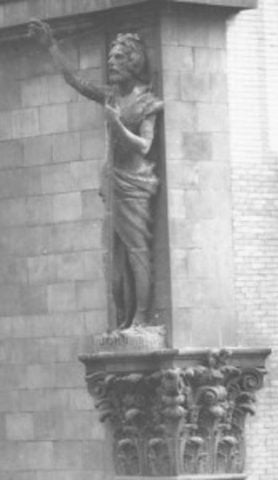
Many, many so called scholars and Jews tell many lies about who John was. Some even say that Jesus was a disciple of John. John was a sinner like all of us, a human being. Jesus was God in the flesh.
“The beginning” – see Jn 1:1.
2 As it is written in the prophets, Behold, I send my messenger before thy face, which shall prepare thy way before thee.
3 The voice of one crying in the wilderness, Prepare ye the way of the Lord, make his paths straight.
4 John did baptize in the wilderness, and preach the baptism of repentance for the remission of sins.
5 And there went out unto him all the land of Judaea, and they of Jerusalem, and were all baptized of him in the river of Jordan, confessing their sins.
“River of Jordan” – even though the Jordan is the principal river in the Holy Land, it is located in the rift valley away from the population centers. It begins form the snows of Mount Hermon and ends at the Dead Sea. Its closest point to Jerusalem is about 20 miles.
6 And John was clothed with camel’s hair, and with a girdle of a skin about his loins; and he did eat locusts and wild honey;
“Camel’s hair” – also worn by Elijah and possibly other prophets.
7 And preached, saying, There cometh one mightier than I after me, the latchet of whose shoes I am not worthy to stoop down and unloose.
8 I indeed have baptized you with water: but he shall baptize you with the Holy Ghost.
“Baptize you with the Holy Ghost” – see Matt 3:11.
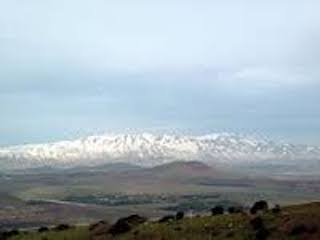
9 And it came to pass in those days that Jesus came from Nazareth of Galilee, and was baptized of John in Jordan.
“In those days” – Jesus probably began His public ministry in or around 27 A.D. when he was approximately 30 years old (Lk 3:23). As far as we know He had spent most of His previous life in Nazareth.
10 And straightway coming up out of the water, he saw the heavens opened, and the Spirit like a dove descending upon him:
1:10-11 – All three persons of the Trinity are involved: (1) the Father speaks, (2) the Son is baptized and (3) the Holy Spirit/Ghost descends on the Son.
“The Spirit…descending upon him” – Jesus’ anointing for ministry – an anointing He claimed in the synagogue at Nazareth (Lk 4:18).
“Like a dove” – symbolizing the gentleness, purity and guilelessness of the Holy Spirit (see Matt 10:16). Yet, the Holy Ghost is not quite as meek as Jesus is. They are all the God and God is love (1 Jn 4:8), but they are also their own person.
The Father and the Holy Ghost are not as gentle or as meek as Jesus is (Matt11:29). If you have a personal relationship with Jesus and you cling to Him then you will see the difference between the three and of course how fantastic they all are.
11 And there came a voice from heaven, saying, Thou art my beloved Son, in whom I am well pleased.
An allusion to Ps 2:7 and Is 42:1.
12 And immediately the Spirit driveth him into the wilderness.
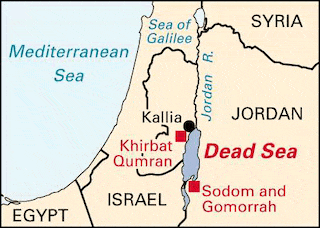
Between Israel and Jordan lies the Dead Sea, a salt lake located on the lowest point of Earth’s surface. Its basin lies some 1,300 feet below sea level, making it the lowest body of water in the world. The lake is about 50 miles long and 11 miles wide.
13 And he was there in the wilderness forty days, tempted of Satan; and was with the wild beasts; and the angels ministered unto him.
“Wild beasts” – in Jesus’ day there were many more wild animals – including lions – in Isaiah than today. Only Mark reports their presence in this connection; he emphasizes that God kept Jesus safe in the wilderness.
“Angels ministered unto him” – as they had attended Isaiah in the wilderness (see Ex 23:20, 23, 32:34), and if you walk with Jesus they will attend to your needs as well.
14 Now after that John was put in prison, Jesus came into Galilee, preaching the gospel of the kingdom of God,
15 And saying, The time is fulfilled, and the kingdom of God is at hand: repent ye, and believe the gospel.
“The kingdom of God is at hand” – the coming of Jesus (the King) brings the kingdom near to the people and He’s still here.
16 Now as he walked by the sea of Galilee, he saw Simon and Andrew his brother casting a net into the sea: for they were fishers.
“Sea of Galilee” – a beautiful lake, almost 700 feet below sea level, 14 miles long and 6 miles wide, fed by the waters of the upper Jordan River. It was called the lake of Gennesaret and the sea of Tiberias.
In Old Testament times it was known as the sea of Chinnereth.
17 And Jesus said unto them, Come ye after me, and I will make you to become fishers of men.
18 And straightway they forsook their nets, and followed him.

19 And when he had gone a little further thence, he saw James the son of Zebedee, and John his brother, who also were in the ship mending their nets.
20 And straightway he called them: and they left their father Zebedee in the ship with the hired servants, and went after him.
21 And they went into Capernaum; and straightway on the Sabbath day he entered into the synagogue, and taught.
“Capernaum Synagogue” – a very important religious institution among the Jews of that day. Originating during the exile, it provided a place where Jews could study the scriptures and worship God.
A synagogue could be established in any town where there were at least ten married Jewish men.
“Taught” – Jesus, like Paul, took advantage of the custom that allowed visiting teachers to participate in the worship service by invitation of the synagogue leaders.
22 And they were astonished at his doctrine: for he taught them as one that had authority, and not as the scribes.
“Astonished” – Mark frequently reported the amazement that Jesus’ teaching and actions produced. It was Christ’s inherent authority that amazed. He did not quote human authorities, as did the teachers of the law, because his authority was directly from God.
23 And there was in their synagogue a man with an unclean spirit; and he cried out,
“A man…cried out” – actually it was the demon who cried out.
“With an unclean spirit” – demonic possession intended to torment and destroy those who are created in God’s image, but the demon recognized Jesus, the one who could and was going to destroy the forces of Satan.
24 Saying, Let us alone; what have we to do with thee, thou Jesus of Nazareth? art thou come to destroy us? I know thee who thou art, the Holy One of God.
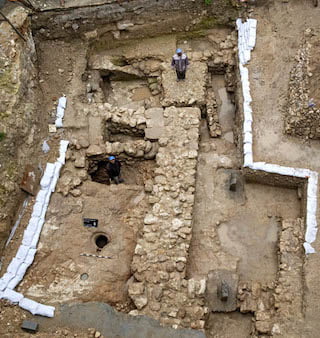
We assume that houses were simply constructed with roughly hewn fieldstones, which were stacked atop each other, held together by smaller stones packed into the spaces, and smeared with clay, mud, or even dung mixed with straw for insulation.
Floors were of packed dirt or beaten earth.
The absence of arches, girders, and roof tiles implies that the roofs were thatched, with wooden ceiling beams supporting a thick bed of straw or reeds, which protected the beams from dampness and was itself covered with packed mud for insulation.
Many of the houses had subterranean cavities. There were bell-shaped cisterns for storing water, and other plastered cisterns would have been used to store grain. Many dwellings were built around caves that were used for living space – which underscores the humble status of the little village.
25 And Jesus rebuked him, saying, Hold thy peace, and come out of him.
26 And when the unclean spirit had torn him, and cried with a loud voice, he came out of him.
27 And they were all amazed, insomuch that they questioned among themselves, saying, What thing is this? what new doctrine is this? for with authority commandeth he even the unclean spirits, and they do obey him.
28 And immediately his fame spread abroad throughout all the region round about Galilee.
29 And forthwith, when they were come out of the synagogue, they entered into the house of Simon and Andrew, with James and John.
30 But Simon’s wife’s mother lay sick of a fever, and anon they tell him of her.
31 And he came and took her by the hand, and lifted her up; and immediately the fever left her, and she ministered unto them.
32 And at even, when the sun did set, they brought unto him all that were diseased, and them that were possessed with devils.
33 And all the city was gathered together at the door.
34 And he healed many that were sick of divers diseases, and cast out many devils; and suffered not the devils to speak, because they knew him.
35 And in the morning, rising up a great while before day, he went out, and departed into a solitary place, and there prayed.
36 And Simon and they that were with him followed after him.
37 And when they had found him, they said unto him, All men seek for thee.
38 And he said unto them, Let us go into the next towns that I may preach there also: for therefore came I forth.
39 And he preached in their synagogues throughout all Galilee, and cast out devils.
40 And there came a leper to him, beseeching him, and kneeling down to him, and saying unto him, If thou wilt, thou canst make me clean.
41 And Jesus, moved with compassion, put forth his hand, and touched him, and saith unto him, I will; be thou clean.
42 And as soon as he had spoken, immediately the leprosy departed from him, and he was cleansed.
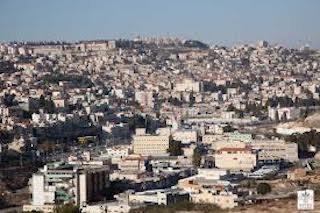
43 And he straitly charged him, and forthwith sent him away;
44 And saith unto him, See thou say nothing to any man: but go thy way, shew thyself to the priest, and offer for thy cleansing those things which Moses commanded, for a testimony unto them.
45 But he went out, and began to publish it much, and to blaze abroad the matter, insomuch that Jesus could no more openly enter into the city, but was without in desert places: and they came to him from every quarter.
“No more openly enter into the city” – Jesus’ growing popularity with the people and the increasing opposition from Jewish leaders finally made it necessary for Him to withdraw from Galilee into surrounding territories.
The Life of Jesus
In what year was Jesus born, and when was he crucified? These are longstanding historical questions. The seemingly obvious answer to the first—that he was born in 1 A.D. (there is no year 0)—is incorrect, however, since the calculations on which our modern calendar is based were faulty.
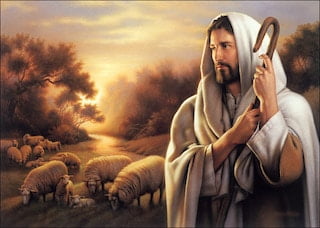
http://www.bible.ca/g-story-jesus.htm
http://www.mormonchannel.org/bible-videos
The basic data of Jesus’ life are well known. After his birth in Bethlehem, he spent most of his youth and early years of ministry in Galilee.
Like many Jews, Jesus would have made trips to Jerusalem and Judea (noted especially in John’s Gospel), but he is also reported to have journeyed at various times into the regions surrounding Galilee, such as Phoenicia (Matt 15:21) and Caesarea Philippi (Matt 16:13).
But most of his life was spent in his hometown of Nazareth and in the fishing villages around the Sea of Galilee. Jesus’ final period of ministry centered on Judea, with the crucifixion and resurrection events occurring in and about Jerusalem.
The chronology of Jesus’ life, though clear in outline, cannot be fixed with absolute precision.
Matthew and Luke both inform us that Jesus was born before the death of Herod (4 B.C.), though it would appear that his birth occurred toward the final years of Herod’s reign, suggesting an approximate date of 6-4 B.C.
The next chronological marker comes from Lk 3:1, where we learn that John the Baptist’s ministry began during the fifteenth year of the reign of the emperor Tiberius.

“And Joseph also went up from Galilee, out of the city of Nazareth, into Judaea, unto the city of David, which is called Bethlehem; (because he was of the house and lineage of David:) To be taxed with Mary his espoused wife, being great with child. And so it was, that, while they were there, the days were accomplished that she should be delivered. And she brought forth her firstborn son, and wrapped him in swaddling clothes, and laid him in a manger; because there was no room for them in the inn” (Lk 2:4-7).
Since 14 A.D. is the generally accepted date for Tiberius’s accession to the throne, John’s ministry would have commenced between August of 28 and December of 29 A.D.
Jesus began his own ministry shortly after John had embarked on his, at some point in 28 or 29 A.D., making Jesus about 32 or 33 years old at the time. This fits well with Luke’s statement that Jesus was “about thirty years old” (Lk 3:23).
The duration of Jesus’ public ministry was approximately three years. While the exact chronology of this period is difficult to ascertain, the final phase of his ministry allows for closer scrutiny.
It is clear that Jesus was crucified under Pontius Pilate, who governed Judea from 26-36 A.D.
Moreover, it is likely that he was put to death on a Friday on the fourteenth day of the Jewish month Nisan, as the Passover lambs were being slaughtered in preparation for the Passover that Friday night; this is the clear Implication of John’s narrative (Jn 18:28; 19:31).
While it is true that in the Synoptic Gospels Jesus referred to the Last Supper, which took place on a Thursday, as a “Passover” meal (e.g., Mk 14:12-16), this may be accounted for in a few different ways.
It has been suggested, with some historical support, that some Jews (in this case Jesus and his Galilean companions) may have reckoned the feast days from sunrise to sunrise rather than from sunset to sunset.
This explanation would accommodate the material both in John and in the Synoptics. It is also possible that Jesus deliberately held his meal on a different day from the Passover because of his intention to radically transform the meaning of the Passover.
Taking Friday, Nisan 14, as the day of the crucifixion, astronomical data informs us that the only years from 29-30 A.D. that could have seen Nisan 14 on a Friday are 30, 33 and 36 A.D.

Thirty-six is easily dismissed as too late, while 30 A.D. seems too early (although some who begin Jesus’ ministry in 28 A.D. and shorten his public ministry find it acceptable). This leaves 33 A.D. as the most likely date for the year of Jesus’ death and resurrection.
…Nazareth.
Visits: 0
